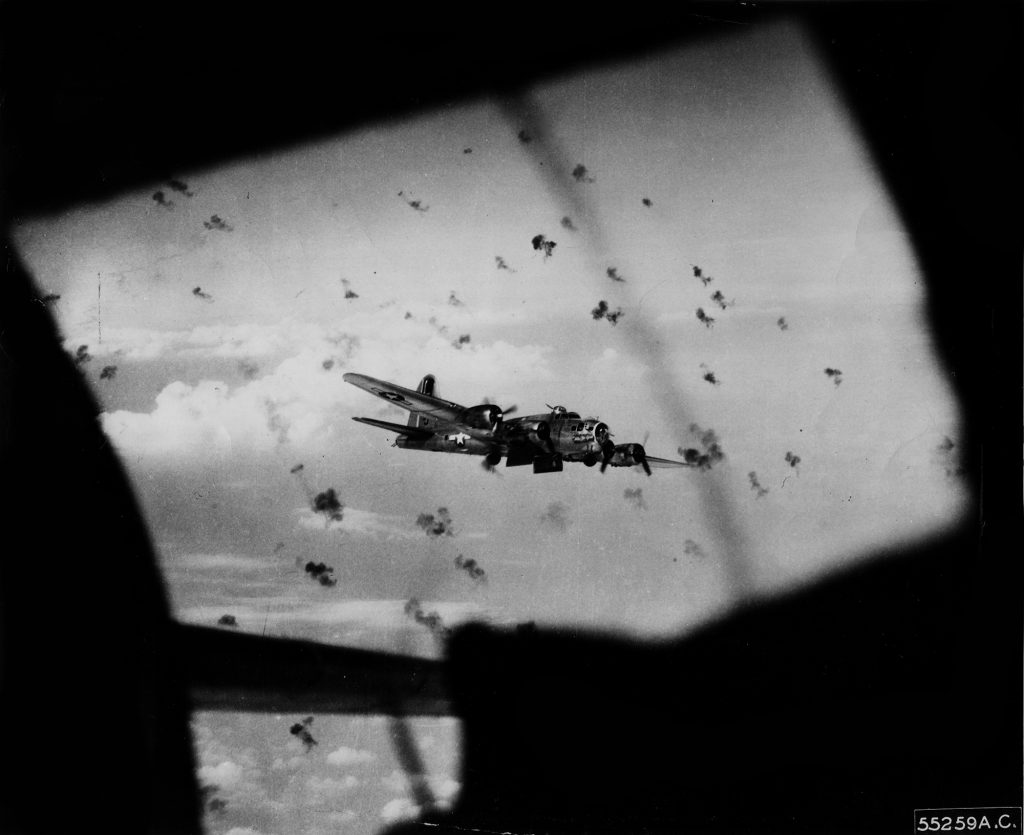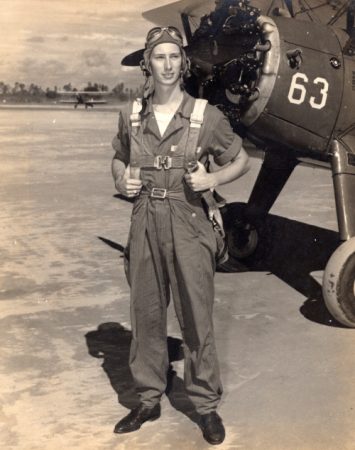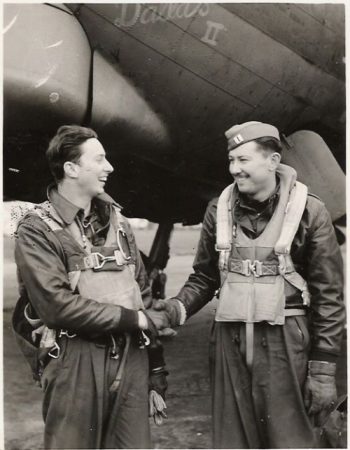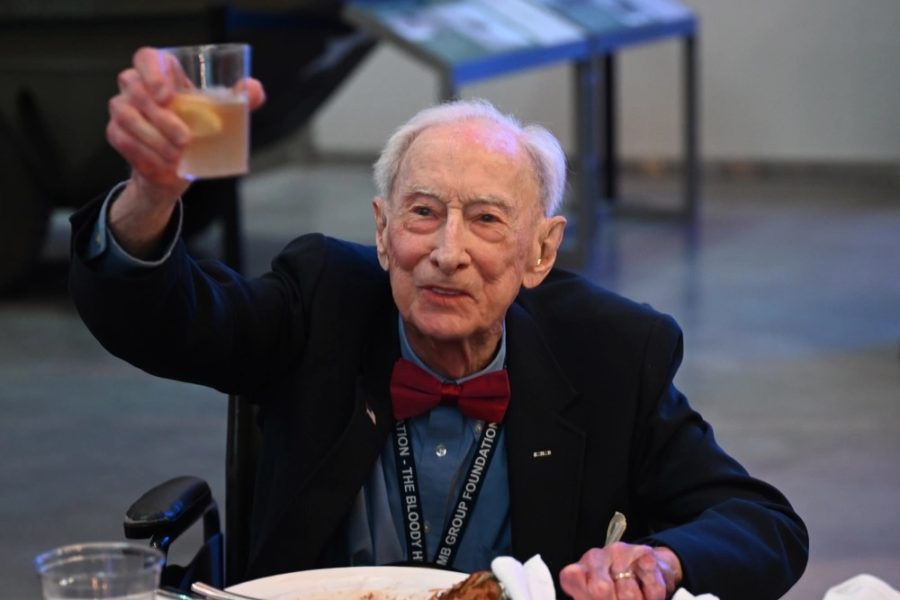“The explosions cut through the wind and drone of the engines. The smoke and shrapnel from the flak was so heavy, some of the crews felt like they could have landed on it. In the cockpit, Lucky hadn’t felt this hopeless since he was stuck in the tail gun with no training and broken guns. All he could do was concentrate on flying, but each explosion forced him to question how he ever let himself get in that spot. He was the poor son of a bitch worrying about his survival.
“Well, you know I’m in this spot, he thought as he scanned the dials in front of him. I’ve got to do the best I can to see it through, and we’ve got to get through this bomb run and drop our bombs.”
This is how the 2022 book, Damn Lucky, describes then-2nd Lt. John “Lucky” Luckadoo’s 22nd combat mission. It was Oct. 8, 1943, and after just four months in Europe, the 100th Bomb Group had lost nearly 90 percent of its original crews. This mission was about to shrink the B-17 bomber cohort even further.

The target was German submarine pens near Bremen, in northwest Germany, and in the way was the densest flak Luckadoo had ever seen and, worse, German fighter planes flying through it to kill the U.S. bombers. Of 18 aircraft from the 100th Bomb Group on the mission, only six returned, including Luckadoo’s damaged King Bee. Each aircraft had a crew of 10.
It took another 82 years but time eventually caught up. Luckadoo was the last of the original cadre. He died Sept. 1 aged 103, having spent much of the intervening years retelling the story of the 8th Air Force and the Bloody 100th. The three-year struggle cost the 8th 26,000 men, 30 percent more dead than the total number of Marines killed in all of World War II.

Luckadoo was just 20 when he joined the Army shortly after the Dec. 7, 1941 Japanese attack on Pearl Harbor. A native of Chattanooga, his best friend, Leroy “Sully” Sullivan, was already flying fighters over North Africa with the Royal Canadian Air Force and he wanted to fly, too. He would fly the four-engined B-17 “Flying Fortress,” a plane bristling with 11 machine guns poking out in nearly every direction.
Flying was dangerous business. More than 15,000 pilots and crew died in training accidents in the U.S. before ever making it overseas, Damn Lucky reports. That’s about seven times as many Americans as killed on D-Day.
Controlling the B-17 “was like grappling with a bear,” New York Times-bestselling author Kevin Maurer wrote in Damn Lucky. “The pilots wrestled the massive planes more than flew them, all while fighting the elements in unpressurized cockpits.” The air was freezing at 25,000 feet. But surviving the 25 combat missions required before they could go home forced those young Airmen to take a dim view of their own chances for survival.
“It didn’t matter if he prayed—he did often—or if he was good at his job,” Maurer wrote. “It was just luck if he came home or not. Nothing else mattered.”

That was especially true in the 100th Bomb Group, which, despite not flying the most missions or dropping the most bombs or suffering the most casualties, earned the nickname “Bloody Hundredth” for “the concentration of casualties over a handful of missions,” according to the Imperial War Museum. Indeed, only one B-17 returned of the 13 the group sent to bomb Münster on Oct. 10, 1943.
“That’s how they got their moniker,” Maurer wrote, “because when they lost, they usually lost big.”
By the end of his tour, many of Luckadoo’s friends were dead, including Sullivan, who died when his engine failed over England. Then-Maj. Luckadoo drank his way through nightmares and survivor’s guilt, especially after returning to the U.S. in March 1944 with nothing to do after completing his 25 missions. But a new training assignment and new love—Barbara, the sister of a fraternity brother’s girlfriend—rescued him. They would marry and remain together 71 years.

Luckadoo got a college degree, went into real estate, moved to Texas. The couple had a daughter. But the former pilot could not fully move through the future without facing his past.
“I didn’t talk about my wartime experiences for more than 50 years because retelling them was not a pleasant exercise,” he wrote in the afterword of Damn Lucky. “I found verbalizing what transpired an agonizing chore. But over time, it has been cathartic.”
Luckadoo shared his story in documentaries and oral histories and served as a technical consultant for the 2024 miniseries Masters of the Air which captured the 100th Bomb Group experience in World War II on Apple TV+. He also advocated for the adoption of a Home Front Heroes Day for the stateside civilians who kept factories humming and “the home fires burning so we had a home to return to and fight for,” he wrote in Damn Lucky.
In 2021, he received the National WWII Museum’s Silver Service Medallion “in recognition of his life of service and leadership,” the museum wrote in a Sept. 2 tribute.
“Lucky served as an incredible standard bearer for his fellow veterans from the ‘Bloody Hundredth,’” the 100th Bomb Group Foundation wrote on Facebook. “He was determined to help keep the legacy of their service alive and educate younger generations about what these men went through during WWII.”



